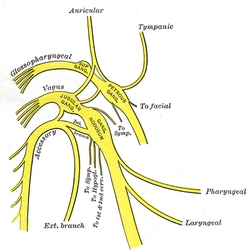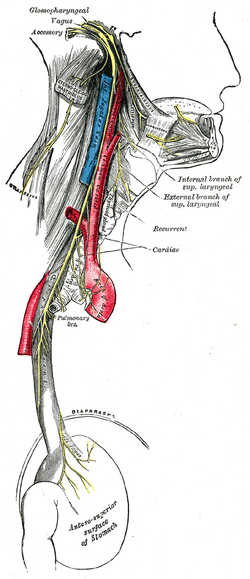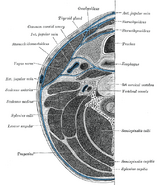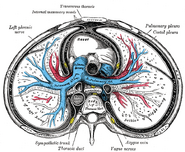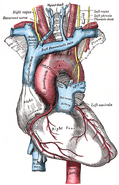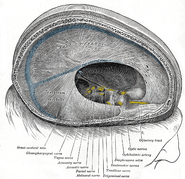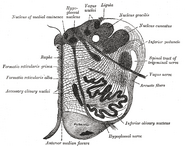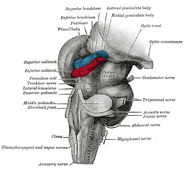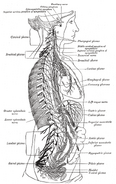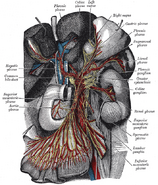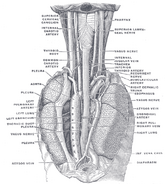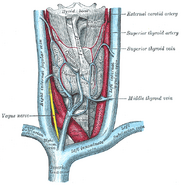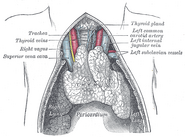| Nerve: Vagus nerve | ||
|---|---|---|
| Plan of upper portions of glossopharyngeal, vagus, and accessory nerves. | ||
| Course and distribution of the glossopharyngeal, vagus, and accessory nerves. | ||
| Latin | nervus vagus | |
| Gray's | subject #205 910 | |
| Innervates | Levator veli palatini, Salpingopharyngeus, Palatoglossus, Palatopharyngeus, Superior pharyngeal constrictor, Middle pharyngeal constrictor, Inferior pharyngeal constrictor | |
| From | ||
| To | ||
| MeSH | A08.800.800.120.900 | |
The vagus nerve (also called pneumogastric nerve or cranial nerve X) is the tenth of twelve paired cranial nerves, and is the only nerve that starts in the brainstem (within the medulla oblongata) and extends, through the jugular foramen, down below the head, to the abdomen.
The medieval Latin word vagus means literally "Wandering" (the words vagrant, vagabond, and vague come from the same root). It is also called the pneumogastric nerve since it innervates both the lungs and the stomach.
Innervation
The vagus descends from the spinal cord in the carotid sheath, lateral to the carotid artery. It carries on past the aortic arch to dip inferiorly behind the left bronchus. Here it forms the pulmonary plexus, after giving rise to the recurrent laryngeal nerve.
The vagus nerve supplies motor parasympathetic fibers to all the organs except the suprarenal (adrenal) glands, from the neck down to the second segment of the transverse colon. The vagus also controls a few skeletal muscles, namely:
- Levator veli palatini muscle
- Salpingopharyngeus muscle
- Palatoglossus muscle
- Palatopharyngeus muscle
- Superior, middle and inferior pharyngeal constrictors
- Muscles of the larynx (speech).
This means that the vagus nerve is responsible for such varied tasks as heart rate, gastrointestinal peristalsis, sweating, and quite a few muscle movements in the mouth, including speech (via the recurrent laryngeal nerve) and keeping the larynx open for breathing. It also receives some sensation from the outer ear, via the Auricular branch (also known as Alderman's nerve) and part of the meninges.
The vagus nerve and the heart
Parasympathetic innervation of the heart is mediated by the vagus nerve. The right vagus innervates the Sinoatrial node. Parasympathetic hyperstimulation predisposes those affected to bradyarrhythmias. The left vagus when hyperstimulated predisposes the heart to Atrioventricular (AV) blocks.
At this location Otto Loewi first proved that nerves secrete substances called neurotransmitters which have effects on receptors in target tissues. Loewi described the substance released by the vagus nerve as vagusstoff, which was later found to be acetylcholine.
The vagus nerve has three associated nuclei, the dorsal motor nucleus, the nucleus ambiguus and the solitary nucleus.
Drugs that inhibit the muscarinic cholinergic receptor (anticholinergics) such as atropine and scopolamine are called vagolytic because they inhibit the action of the vagus nerve on the heart, gastrointestinal tract and other organs. Anticholinergic drugs increase heart rate and are used to treat bradycardia(slow heart rate) and asystole, which is when the heart has no electrical activity. Anticholinergic drugs relax the detrusor muscle and cause constipation which again involves the vagus nerve.
Bulimics and anorexics have high vagal activity which is associated with the arrhythmias seen in these patients.
Medical treatment involving the vagus nerve
Treatment of epilepsy
Vagus nerve stimulation (VNS) therapy using a pacemaker-like device implanted in the chest is a treatment used since 1997 to control seizures in epilepsy patients.
Drug resistant or refractory seizures, myoclonic seizures and Lennox-Gastaut syndrome treated by VNS have all been recorded with neurovisceral (neuropsychiatric) porphyrias (acute intermittent porphyria, hereditary coproporphyria, variegate porphyria). These highly drug and environmentally induced genetic disorders can cause seizures, chronic epilepsy and significant damage to the neuroendocrine and peripheral nervous systems including marked vagal nerve dysfunction. Before implantation of VNS these genetic disorders should be investigated in patients with epilepsy since most antiseizure drugs are porphyrinogenic and aggravate porphyrias. Children require enzyme or DNA testing since significant porphyrin production and excretion may not occur prepuberty.
A degree of intermittent VNS can be achieved by daily breathing exercises (for example, Pranayama) over a period of several weeks. In some patients, such proactive relaxation exercises have been found to correlate with lower blood pressure and lower heart rate and more stable moods.[How to reference and link to summary or text] The Valsalva maneuver may activate the vagus nerve and is a "natural" way to achieve the same effect in some patients. Patients with atrial fibrillation, supraventricular tachycardia and other illnesses may be trained to perform the valsalva maneuver (or find it for themselves).
Treatment of depression
- Main article: Depression - Vagus nerve stimulation
Vagus nerve stimulation (VNS) has recently been approved for treating drug-resistant cases of clinical depression.[1] A convenient, non-invasive VNS device that stimulates an afferent branch of the vagus nerve is also being developed and will soon undergo trials.
Vagotomy (cutting of the vagus nerve) is a now-obsolete therapy that was performed for peptic ulcer disease.
Physical and emotional effects
Activation of the vagus nerve typically leads to a reduction in heart rate, blood pressure, or both. This occurs commonly in the setting of gastrointestinal illness such as viral gastroenteritis or acute cholecystitis, or in response to other stimuli, including carotid sinus massage, Valsalva maneuver, or pain from any cause, particularly having blood drawn. When the circulatory changes are great enough, vasovagal syncope results. Relative dehydration tends to amplify these responses.
Excessive activation of the vagal nerve during emotional stress, which is a parasympathetic overcompensation of a strong sympathetic nervous system response associated with stress, can also cause vasovagal syncope because of a sudden drop in blood pressure and heart rate. Vasovagal syncope affects young children and women more often. It can also lead to temporary loss of bladder control under moments of extreme fear.
Effects of vagus nerve lesions
The patient complains of hoarse voice, difficulty in swallowing and choking when drinking fluid.
Additional images
See also
References & Bibliography
Key texts
Books
Papers
Additional material
Books
Papers
Dissertations
- Bell, T. P. (2007). A study of the effects of vagus nerve stimulation on anxiety in laboratory rats. Dissertation Abstracts International: Section B: The Sciences and Engineering, 68(5-B).
- Clark, K. B. (1999). Studies investigating the role played by vagus nerve stimulation in the modulation of memory formation. (verbal recognition tasks, learning). Dissertation Abstracts International: Section B: The Sciences and Engineering, 60(4-B).
- Markus, T. M. (2003). An investigation into the modulatory effects of vagus nerve stimulation on emotional expression in laboratory rats. Dissertation Abstracts International: Section B: The Sciences and Engineering, 63(9-B).
- Krahl, S. E. (1995). Vagus nerve stimulation for the control of seizures: Possible modulatory role of the locus coeruleus. Dissertation Abstracts International: Section B: The Sciences and Engineering, 56(1-B).
- Starbuck, E. M. (2001). The subfornical organ and vagus nerve: A similar role in hypernatremic thirst demonstrated by hypothalamic fos-immunoreactivity. Dissertation Abstracts International: Section B: The Sciences and Engineering, 62(5-B).
- Talley, C. E. P. (1999). Peripheral nervous system influences on spontaneous alternation behavior: A role for the vagus nerve. Dissertation Abstracts International: Section B: The Sciences and Engineering, 60(1-B).
- Tan, A. A. (2007). Effects of vagus nerve stimulation on recovery of function following controlled cortical impact brain injury. Dissertation Abstracts International: Section B: The Sciences and Engineering, 67(8-B).
- Zuo, Y. (2006). An investigation of the modulatory effect of vagus nerve stimulation on hippocampal LTP in freely moving rats. Dissertation Abstracts International: Section B: The Sciences and Engineering, 66(11-B).
External links
- MedEd at Loyola grossanatomy/h_n/cn/cn1/cn10.htm
- Cranial Nerves at Yale 10-1
- Human anatomy at Dartmouth figures/chapter_24/24-7.HTM
- Norman/Georgetown cranialnerves (X)
I-IV: olfactory - optic - oculomotor - trochlear
V: trigeminal: trigeminal ganglion
V1: ophthalmic: lacrimal - frontal (supratrochlear, supraorbital) - nasociliary (long root of ciliary, long ciliary, infratrochlear, posterior ethmoidal, anterior ethmoidal) - ciliary ganglion (short ciliary)
V2: maxillary: middle meningeal - in the pterygopalatine fossa (zygomatic, zygomaticotemporal, zygomaticofacial, sphenopalatine, posterior superior alveolar)
in the infraorbital canal/infraorbital nerve (middle superior alveolar, anterior superior alveolar)
on the face (inferior palpebral, external nasal, superior labial, infraorbital plexus) - pterygopalatine ganglion (deep petrosal, nerve of pterygoid canal)
branches of distribution (palatine, nasopalatine, pharyngeal)
V3: mandibular: nervus spinosus - medial pterygoid - anterior (masseteric, deep temporal, buccal, lateral pterygoid)
posterior (auriculotemporal, lingual, inferior alveolar, mylohyoid, mental) - otic ganglion - submandibular ganglion
VI: abducens
VII: facial: nervus intermedius - geniculate - inside facial canal (greater petrosal, nerve to the stapedius, chorda tympani)
at exit from stylomastoid foramen (posterior auricular, digastric - stylohyoid)
on face (temporal, zygomatic, buccal, mandibular, cervical)
VIII: vestibulocochlear: cochlear (striae medullares, lateral lemniscus) - vestibular
IX: glossopharyngeal: fasciculus solitarius - nucleus ambiguus - ganglia (superior, petrous) - tympanic - carotid sinus
X: vagus: ganglia (jugular, nodose) - Alderman's nerve - in the neck (pharyngeal branch, superior laryngeal ext and int, recurrent laryngeal)
in the thorax (pulmonary branches, esophageal plexus) - in the abdomen (gastric plexuses, celiac plexus, gastric plexus)
XI: accessory XII: hypoglossal
| This page uses Creative Commons Licensed content from Wikipedia (view authors). |
